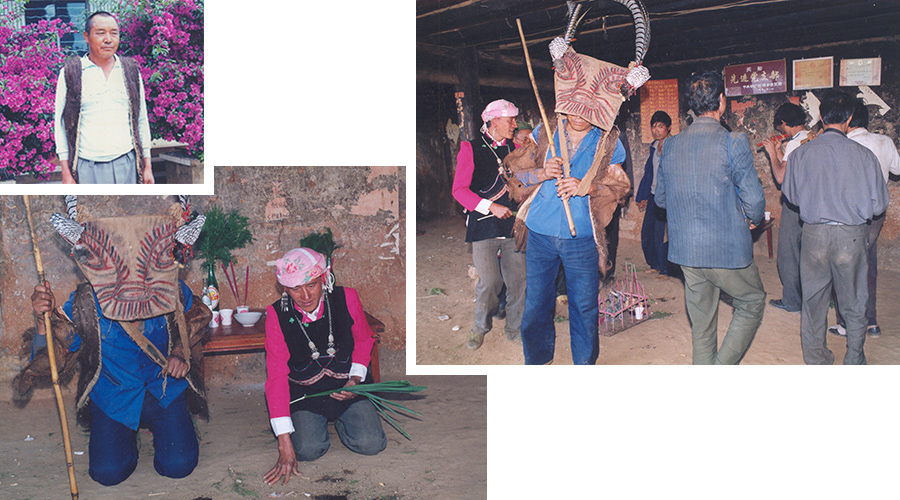Li Dejin – Inheritor of Yi Traditional Sacrificial Dance “Dancing Mute” in Yimen County, Yuxi
Li Dejin’s Background
Li Dejin, a male of the Yi (彝族) ethnic group, was born in 1944 in Bido Village, Tongchang Township, Yimen County, Yuxi City. He is the provincial-level inheritor of the “Jumping Mute” (跳哑巴) dance, a form of intangible cultural heritage.
Learning and Inheritance
Influenced by his father Li Guoxiu, Li Dejin developed a strong curiosity and admiration for the “Jumping Mute” dance from an early age. At the age of 16, he began learning the dance from the elder Lu Fa in his village and gradually became the inheritor of this traditional dance. Li Dejin is deeply aware of the significance of the “Jumping Mute” dance and once said, “If you like to learn, then learn it well with me; if one day I am no longer here, no one will be able to perform the ‘Jumping Mute’ anymore.”
Dance Features
The “Jumping Mute” is a Yi (彝族) sacrificial dance with a profound cultural background, primarily passed down in Bido Village, Tongchang Township, Yimen County. The dance is typically performed on the fourth day of the first lunar month and consists of six parts: worshiping gods, setting up the altar, jumping mute, killing the mute, eating the mute meat, and celebrating. The dance features rich movements, including many high-level techniques, and has unique artistic charm.

Inheritance and Protection
Li Dejin not only masters the “Jumping Mute” dance himself but also actively cultivates younger generations of inheritors. His son and son-in-law, Zhuo Gui, are among those learning and inheriting this traditional art. Additionally, Li Dejin actively participates in various cultural activities and performances, promoting the “Jumping Mute” dance.
Honors and Contributions
In June 2007, Li Dejin was named an inheritor of the intangible cultural heritage of Yunnan Province. His efforts led to the “Jumping Mute” dance being included in the cultural protection list of the Yuxi Municipal People’s Government in 2006. Through his actions, Li Dejin has made significant contributions to the protection and inheritance of this unique ethnic culture.
As the inheritor of the “Jumping Mute” dance, Li Dejin has not only preserved the form of this traditional art but also made innovations and educated the next generation, ensuring its continuation and development in modern society.
Li Dejin’s Methods of Cultivating Young Inheritors
As a provincial-level inheritor of the “Jumping Mute” dance, Li Dejin uses various methods to train young inheritors. The main methods include:
1. Teaching by Example
Li Dejin imparts the techniques and cultural connotations of the “Jumping Mute” dance through personal demonstration and explanation. He not only teaches the dance movements but also shares the related legends and cultural background, allowing his students to gain a comprehensive understanding of this traditional art.
2. Selecting Suitable Apprentices
Li Dejin focuses on choosing young people who have an interest in and potential for the “Jumping Mute” dance as his apprentices. His apprentice Zhuo Gui has already mastered the basic routines of the “Mute King” and, under Li Dejin’s guidance, has gradually become part of the new generation of inheritors.
3. Participation in Cultural Activities
Li Dejin involves his apprentices in various cultural activities and performances, helping them improve their performance abilities through practice. For example, he led his apprentices to participate in the Yunnan Province ethnic song and dance evening, “Jump Yunnan,” and perform at the 3rd China Art Festival, where they received widespread recognition.
4. Combining Cultural Inheritance with Education
Li Dejin actively participates in local cultural inheritance activities, using school education and community activities to introduce the “Jumping Mute” dance to more young people. This educational approach not only cultivates potential inheritors but also raises public awareness and interest in this intangible cultural heritage.
Through these methods, Li Dejin has successfully passed on the skills of the “Jumping Mute” dance to the younger generation, sparked greater interest and love for this traditional art, and laid a solid foundation for the inheritance and development of the “Jumping Mute” dance.
For Chinese version please go to:
http://www.ynich.cn/view-ml-13111-3339.html

 7 Days GolfingTour
7 Days GolfingTour
 8 Days Group Tour
8 Days Group Tour
 8 Days Yunnan Tour
8 Days Yunnan Tour
 7 Days Shangri La Hiking
7 Days Shangri La Hiking
 11 Days Yunnan Tour
11 Days Yunnan Tour
 6 Days Yuanyang Terraces
6 Days Yuanyang Terraces
 11 Days Yunnan Tour
11 Days Yunnan Tour
 8 Days South Yunnan
8 Days South Yunnan
 7 Days Tea Tour
7 Days Tea Tour
 8 Days Muslim Tour
8 Days Muslim Tour
 12 Days Self-Driving
12 Days Self-Driving
 4 Days Haba Climbing
4 Days Haba Climbing
 Tiger Leaping Gorge
Tiger Leaping Gorge
 Stone Forest
Stone Forest
 Yunnan-Tibet
Yunnan-Tibet
 Hani Rice Terraces
Hani Rice Terraces
 Kunming
Kunming
 Lijiang
Lijiang
 Shangri-la
Shangri-la
 Dali
Dali
 XishuangBanna
XishuangBanna
 Honghe
Honghe
 Kunming
Kunming
 Lijiang
Lijiang
 Shangri-la
Shangri-la
 Yuanyang Rice Terraces
Yuanyang Rice Terraces
 Nujiang
Nujiang
 XishuangBanna
XishuangBanna
 Spring City Golf
Spring City Golf
 Snow Mountain Golf
Snow Mountain Golf
 Stone Mountain Golf
Stone Mountain Golf













